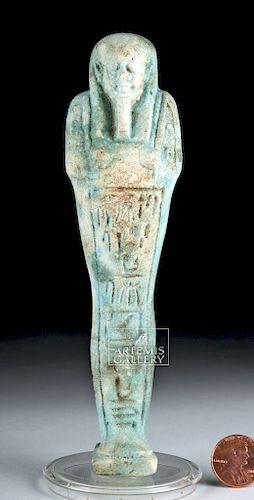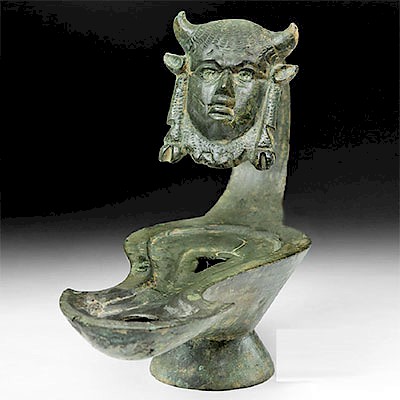Translated Egyptian Faience Ushabti, ex-Bonhams
Lot 4
About Seller
Artemis Fine Arts
686 S Taylor Ave, Ste 106
Louisville, CO 80027
United States
Selling antiquities, ancient and ethnographic art online since 1993, Artemis Gallery specializes in Classical Antiquities (Egyptian, Greek, Roman, Near Eastern), Asian, Pre-Columbian, African / Tribal / Oceanographic art. Our extensive inventory includes pottery, stone, metal, wood, glass and textil...Read more
Estimate:
$900 - $1,400
Absentee vs Live bid
Two ways to bid:
- Leave a max absentee bid and the platform will bid on your behalf up to your maximum bid during the live auction.
- Bid live during the auction and your bids will be submitted real-time to the auctioneer.
Bid Increments
| Price | Bid Increment |
|---|---|
| $0 | $25 |
| $300 | $50 |
| $1,000 | $100 |
| $2,000 | $250 |
| $5,000 | $500 |
| $10,000 | $1,000 |
| $20,000 | $2,500 |
| $50,000 | $5,000 |
| $100,000 | $10,000 |
| $200,000 | $20,000 |
About Auction
By Artemis Fine Arts
Sep 27, 2018
Set Reminder
2018-09-27 10:00:00
2018-09-27 10:00:00
America/New_York
Bidsquare
Bidsquare : Antiquities | Asian | Ethnographic
https://www.bidsquare.com/auctions/artemis-gallery/antiquities-asian-ethnographic-3469
Featuring classical antiquities, ancient and ethnographic art from cultures encompassing the globe. Artemis Fine Arts info@artemisfinearts.com
Featuring classical antiquities, ancient and ethnographic art from cultures encompassing the globe. Artemis Fine Arts info@artemisfinearts.com
- Lot Description
Egypt, Late Dynastic to Ptolemaic periods, ca. 664 to 30 BCE. A mold-formed blue-green faience ushabti standing in mummiform atop an integral rectangular plinth. The figure's arms are crossed atop its chest, with hands clenching the symbolic pick and hoe to tend to the fields of Osiris in the afterlife. A tripartite wig frames a stylized face comprised of almond-shaped eyes, a prominent nose, cupped ears, full lips drawn into a slight smile, and a plaited false beard. A single column of hieroglyphic characters decorate the front of the legs and lower torso. Translated, the text reads that this ushabti was created for a man named "Ipethemes, born to Hathor-em-akhet." A beautiful example from the latter periods of pharaonic Egypt! Custom lucite display stand included. Size: 1.625" W x 6" H (4.1 cm x 15.2 cm); 6.375" H (16.2 cm) on included custom stand.
Ushabti dolls are figures shaped like adult male or female mummies wearing traditional ancient Egyptian headdresses. The ancient Egyptians believed that after they died, their spirits would have to work in the "Field of Reeds" owned by the god of the underworld, Osiris. This meant doing agricultural labor - and it was required by all members of society, from workers to pharaohs. The wealthier nobility in Egyptian society were able to have shabtis made of faience; blue faience was meant to reflect the color of the river Nile both on earth and in the afterlife.
Provenance: private Houston, Texas, USA collection; ex-Bonham's London Antiquities Auction, 8 May, 2013, part of lot 339; ex-English private A.B. collection, United Kingdom, acquired before 1970
All items legal to buy/sell under U.S. Statute covering cultural patrimony Code 2600, CHAPTER 14, and are guaranteed to be as described or your money back.
A Certificate of Authenticity will accompany all winning bids.
We ship worldwide and handle all shipping in-house for your convenience.
#132795Ushabti is adhered to lucite stand. Age-commensurate surface wear and abrasions, small nicks to integral plinth and head, fading to some hieroglyphic text and coloration, otherwise intact and excellent. Light earthen deposits within recessed areas and along verso.Condition
- Shipping Info
-
All shipping is handled in-house for your convenience. Your invoice from Artemis Gallery will include shipping calculation instructions. If in doubt, please inquire BEFORE bidding for estimated shipping costs for individual items.
-
- Buyer's Premium



 EUR
EUR CAD
CAD AUD
AUD GBP
GBP MXN
MXN HKD
HKD CNY
CNY MYR
MYR SEK
SEK SGD
SGD CHF
CHF THB
THB














